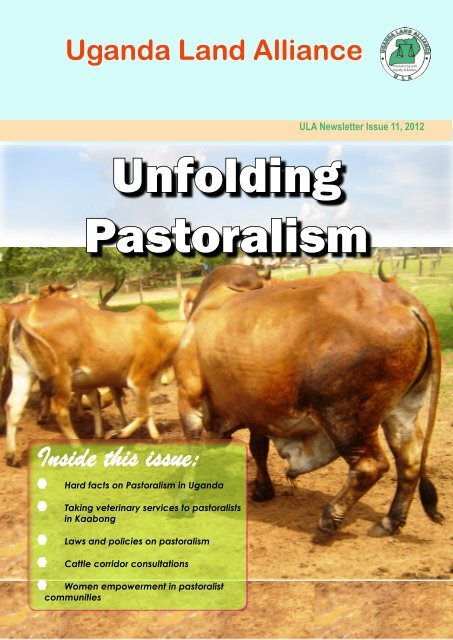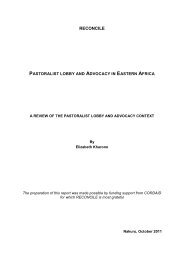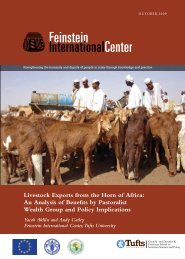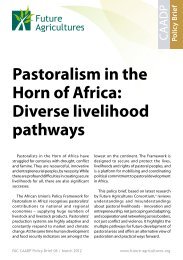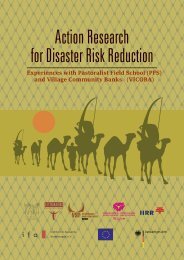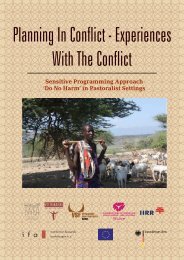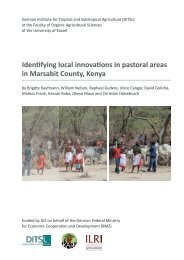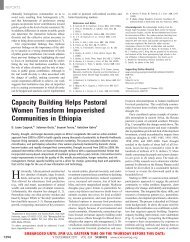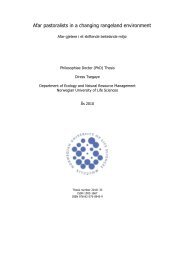ULA newsletter - Pastoralism (issue 11 Dec 2012).pdf - celep
ULA newsletter - Pastoralism (issue 11 Dec 2012).pdf - celep
ULA newsletter - Pastoralism (issue 11 Dec 2012).pdf - celep
You also want an ePaper? Increase the reach of your titles
YUMPU automatically turns print PDFs into web optimized ePapers that Google loves.
Uganda Land Alliance<strong>ULA</strong> Newsletter Issue <strong>11</strong>, <strong>2012</strong>Unfolding<strong>Pastoralism</strong>Inside this <strong>issue</strong>:Hard facts on <strong>Pastoralism</strong> in UgandaTaking veterinary services to pastoralistsin KaabongLaws and policies on pastoralismCattle corridor consultationsWomen empowerment in pastoralistcommunities- 1 -
Editor’s wordIt’s <strong>Dec</strong>ember again. Christmas and end ofyear festivities have started and this meanslots of drinks and eats for whoever canafford.In most households, beef is high on theshopping list but while we bargain for thebest cuts at the stalls, how many of us evercare to know the origin of the nutritiousdelicacy?Nutritionists tell us that beef is an excellentsource of protein and other nutrients. At thesame time, beef liver contains iron, vitaminsand proteins necessary for the development,growth and maintenance of muscles, organs,bones and other body t<strong>issue</strong>.Despite health concerns regarding eating redmeat daily, there is a leeway that beef frompasture-raised animals which eat plantsand insects is safer. If this is anything to goby, we should all contribute to sustainablepastoralism so as to enjoy grass-fed beeffor the good of our health. It is unlikelythat other cattle keepers can satisfy thedemand for beef without the contribution ofpastoralists.Unfortunately, pastoralistsdo not have the luxury ofenjoying Christmas and otherfestivities the way the rest ofus do since animals must begrazed and watered every day.It is a vocation that recognizesno holidays or big days.While those involved in cattletransportation, selling, meatpreparation and processingmay take a break to enjoy thefruits of their labour, pastoralists will be out in thewilderness searching for the best pasture to feed theanimals we shall feast on the following day.According to the Bible (Luke 2:8-20), shepherds werethe first to receive news of the birth of Jesus Christwhile they watched over their flocks at night. Abel,one of the two sons of Adam, was also a pastoralist.Just as it was in the beginning, may the blessingsof the festive season cover those tending the flocks(and herds) and spread to the rest of us who feast onthe products of their labour.Merry Christmas and a happy new year.Proscovia NnamulondoSolid FactsBy Odokorach Shanty FrancisA herd of longhorn cattle common among pastoral communities- 2 -
<strong>Pastoralism</strong> and the law in UgandaBy Esther AkwiiThe Humanitarian Policy Group noted in 2009that policy plays a critical role in guiding thechoice-making process, identifying the problemsto be addressed, establishing parameters andputting in place structures and institutions. InUganda, pastoral <strong>issue</strong>s have been addressed inthe Constitution, the National Land Policy andthe draft Rangeland Management and <strong>Pastoralism</strong>Policy. Below are excerpts of what the different lawsand policies say in regard to pastoralism:Article 237(1) of the Constitution states that landin Uganda belongs to the citizens of Uganda andshall be vested in them in accordance with the landtenure systems provided for in the Constitution. Subsection 3 states that land in Uganda shall be ownedin accordance with the following tenure systems—(a) Customary(b) Freehold(c) Mailo(d) Leasehold.The Uganda National Land Policy (Section 60)provides for land rights of pastoral communitiesand gives an insight into the prevailing situation:“These communities occupy rangelands with harshclimatic and ecological conditions. The severityof competition for grazing and water resourceswith neighboring communities has increased, ascultivators encroach more and more into areassuitable for grazing... Because of their diverseresources, the land use in the rangelands is fastbroadening. This has bred hitherto unknownpractices like land grabbing, large scale buying andfencing off of land which are threatening pastorallivelihoods. It is necessary to recognise and protectthe rights of non – pastoral communities but notat the expense of pastoralists who are the primaryusers of the rangelands.”Policy statement 61 of the land policy statesthat land rights of pastoral communities will beguaranteed and protected by the state to:1. Ensure that pastoral lands are held, ownedand controlled by designated pastoralcommunities as common property undercustomary tenure;2. Develop particular projects for adaptation andreclamation of pastoral lands for sustainableproductivity and improved livelihood ofcommunities;3. Protect pastoral lands from indiscriminateappropriation by individuals or corporateinstitutions under the guise of investment;4. Promote the establishment of CommunalLand Associations and use of communalland management schemes among pastoralcommunities;- 3 -Pastoralists with their herd of cattle leave a watering point5. Establish efficient mechanisms for the speedyresolution of conflict over pastoral resources,and between pastoral communities andsedentary communities.Under the land policy, it is the duty of governmentto protect pastoralists’ land rights throughprescribing clear principles for the ownership,control and management of pastoral lands; carryingout voluntary resettlement with approval of localgovernments; maintaining an equitable balancebetween the use of land for pasture, agriculture,energy, industry and wildlife protection;establishing mechanisms for flexible and negotiatedcross-border access to pastoral resources amongclans, lineages and communities for their mutualbenefit; and considering restitution, compensationor resettlement of pastoral communities who havelost land to government over the years.The draft Rangeland and <strong>Pastoralism</strong> Policyprovides for sustainable rangeland resource useand environmental protection aimed to sustain soilfertility, increase crop and livestock productivity,and protect the ecosystem. It further provides forinfrastructure development and research, trainingand advisory service delivery programmes thatenhance efficiency and profitability in priorityareas. It also covers areas such as local people’sparticipation and gender inclusiveness, wildlife andtourism development, mitigation of conflicts anddevelopment of a code to govern pastoral activitiesin Uganda.The above provisions indicate the commitment toimprove pastoral livelihoods through policy andpractice change in order to reduce risks within thepastoral system. However, while addressing pastoral<strong>issue</strong>s in policies is a positive step, the bigger task isto implement what has been put on paper.
Member Profile:Coalition for Pastoral Civil Society OrganisationsPastoralists match during celebrations to mark the Uganda Pastoralists’ Week in Moroto.The Coalition for Pastoral Civil Society Organisations(COPACSO) was formed in 2005 as a loose coalitionof civil society organisations working for theadvancement of pastoralists in Uganda. It providesa platform for member organisations to engage inpolicy formulation and advocacy for recognition ofpastoralism and the right of pastoralists to benefitfrom national and local resources. The goal of thecoalition is to achieve national policy and localpractices that enhance capabilities and improve thewelfare of pastoralists.As cross cutting activities to pastoralism and mostespecially government’s reactivation of the processof developing the Uganda Rangelands ManagementPolicy took root, members thought it no longertenable to have COPACSO as a loose organization.They felt there was need to register it and establisha full time Secretariat. An application was lodgedwith the NGO Board and on 23rd March <strong>2012</strong>,COPACSO was registered. It currently has over20 member organisations spread across the cattlecorridor. It is also a partner of the Coalition ofEuropean Lobbies for Eastern African <strong>Pastoralism</strong>(CELEP) which works to help pastoralists benefitfrom the programs and activities of the EuropeanUnion.Today, COPACSO is chaired by Ms Esther Obaikol,who is also the Executive Director of the UgandaLand Alliance (<strong>ULA</strong>). COPACSO shares office spacewith <strong>ULA</strong> and the two share some functions likeaccounting and administration. It has three staffmembers: the Coordinator, the Program Officer andthe Finance Assistant. Most of the funding receivedso far is from the Irish Aid through Oxfam.- 4 -The Coalition elevated the profile of pastoralistsby holding the inaugural Uganda Pastoralist Week(UPW) in 2006. Since then, similar events havebeen held in 2008, 2009 and 20<strong>11</strong> with support fromdevelopment partners. These have increased thevisibility of pastoralists.COPACSO has been an active member of the processof developing the Uganda Rangelands ManagementPolicy now renamed the Uganda Rangelands and<strong>Pastoralism</strong> Policy (URPP). Apart from conductingtechnical reviews of the draft policy and the Uganda<strong>Pastoralism</strong> Code, it has funded and directlyparticipated in conducting community consultationson the policy in Apac, Buliisa, Kaabong, Kiboga,Kotido and Moroto districts.COPACSO has been active in other activities likethe development of Uganda’s Comprehensive AfricaAgriculture Development Program paper andcontributed to the development of implementationstrategies for the African Union Policy Frameworkon <strong>Pastoralism</strong>.In the coming year, COPACSO will continue toengage with the Ministry of Agriculture, AnimalIndustry and Fisheries to finalize the URPP. Itwill also actively participate with the Ministryof Agriculture in the formulation of the FAO andWorld Bank sponsored regional pastoral livelihoodsresilience project. Another key engagement will beto work towards building a bigger regional voiceon pastoralism so that the benefits accruing out ofregional cooperation like the East African CommonMarket improve access to better markets forpastoral products.
Uganda Rangelands Policy:Findings from community consultations in six districtsBy Benjamin MutambukahThe Uganda government is in the process ofdeveloping the Uganda Rangelands and <strong>Pastoralism</strong>Policy (URPP). The specific objectives of the policyinclude securing effective participation of allstakeholders; promoting user understanding of theneed for environmental protection; facilitating evendistribution of water; and improving the qualityof pasture. Other objectives include enhancingharmonious co-existence among the various users,attracting public and private investment in therangeland that is consistent with the primaryusers, and strengthening service delivery.Whereas the process of developing the URPP beganfar back in 2006, it has been on and off due tofunding constraints. One of the key elements of theprocess is the need to consult communities livingand working in the rangelands commonly known asthe cattle corridor. Prior to 2008, consultations wereheld in the ten districts of Isingiro, Kapchorwa,Kiruhura, Kumi, Nakaseke, Nakasongola,Ntungamo, Sironko, Ssembabule, and Soroti. Thisleft out the whole of Northern Uganda includingKaramoja region because of the insecurity thatprevailed in those areas at the time.In April <strong>2012</strong>, COPACSO, with funding fromIrish Aid through Oxfam GB and DanChurchAid,undertook consultations in three districts ofKaramoja (Kaabong, Kotido and Moroto) where atotal of 522 people from different communities wereconsulted. Out of these, 221(42%) were women.In September <strong>2012</strong>, COPACSO conducted otherconsultations in the districts of Apac, Buliisa andKiboga where a total of 444 community memberswere consulted of whom 132(30%) were women.Apart from the communities, other key informersincluded technical and political leaders andrepresentatives of the private sector.At community level, consultations were undertakenmainly through focus group discussions wherebymen, the elderly, women and youths were separatelyasked in their own languages to state how they useland, recent changes in land use and their causes,effects and proposed solutions including who theyconsidered best placed to address the negativeeffects.A number of cross cutting <strong>issue</strong>s were noted:insecurity of land tenure mainly from investorsin Karamoja and the oil industry in Buliisa werebig concerns. In Kiboga, the major concern was thepractice of wealthy people buying large chunks ofland and fencing it off. These developments had- 5 -Community consultations in Ibuje Sub County, Apac District.resulted into increased curtailment of mobilityof community members which is a key copingmechanism in cases of drought and diseaseoutbreaks.In all the districts, land available for grazing wasreported to be decreasing due to a combination offactors: increasing human and livestock population,gazetting of some areas as protected, competingland use like mining, tree planting, crop farming,degradation, and acquisition of big chunks of landby a few individuals who fence it off.The state of service delivery was found wantingin all the six districts with poor coverage of roads,schools, electricity, banking, water, marketsand health centres. The communities called foradaptation of service delivery to their lifestyle.Extension services too were found inadequate. Inthe three districts of Karamoja, only Moroto hadtwo veterinary doctors but the rest had one each.The lack of personnel was said to be compoundedby the liberalization of veterinary services whichmade drugs very expensive. The overall inadequateservice provision impacted negatively on livelihoodsby increasing morbidity and mortality rates ofpeople and livestock. Government was calledupon to promote affirmative action in the provisionof services to pastoralist communities includingcreating incentives for the retention of personnel inhard to reach areas.The increasing commercialization of land andlivestock was reported to be leading to cases of landgrabbing and cattle theft. In areas of Karamoja,cont/d to page 9
Securing the land rights of KaramojongPastoralistsBy Odokorach Shanty FrancisIt is a common myth amongUgandans that pastoralism,which constitutes the key land useactivity in Karamoja is ‘backward’and so are those who practice it.Unfortunately, this myth infectedeven the minds of policy makersin Uganda as evidenced in policiestowards Karamoja region fromcolonial times to post independenceregimes, with arguably theworst policy context being on theKaramojong land rights.Oxfam in partnership with UgandaLand Alliance (<strong>ULA</strong>) and localnon-governmental organizationswith support from Irish Aid have implemented alivelihood programme in Karamoja since 2007. Thisinitiative aims to increase responsiveness of nationalpolicies to pastoralist livelihoods and the needs ofthe people of Karamoja. Specifically, <strong>ULA</strong> advocatesfor establishment of systems that address threatsto tenure security and sustainable pastoralism, andincreased knowledge and citizen participation inland management and tenure security.Since 20<strong>11</strong>, <strong>ULA</strong> has registered significant milestonestowards securing the land rights of pastoralists andagro-pastoralists in Karamoja; <strong>ULA</strong> has conductedconsultations with both traditional and formalgovernance systems to identify opportunitiesfor synergies. The organization has establishedand trained Area Land Committees, communityparalegals and land recorders as key entry pointsinto establishing strong grassroot structures thatcan mobilize the communities to be more aware oftheir land rights and be able to access the requiredsupport to acquire legaldocumentation of theircommunal land.<strong>ULA</strong> has securedcommitment from districtleadership in all thedistricts of Karamoja to setup a regional land office inMoroto district to facilitatethe acquisition of landownership documentationfor the communal customaryland across the region. Thisagreement was reachedat a regional consultativemeeting held in September<strong>2012</strong> in Kotido district.The meeting agreed that alldistricts shall appoint andsubmit the names of districtOdokorach Shanty Francisland board members to the Ministryof Lands for approval as one of the keysteps to ensuring that the provisionsof the Land Act are implementedin Karamoja. <strong>ULA</strong> is committed tosupporting communities to form landassociations that will lead the processof applying for communal certificatesof land ownership as provided forby the Land Act. Communal landassociations will be formed at subcounty level using the existing clanstructures.In the same strategy, integration ofwomen and youth into the communalland associations has been agreedto by communities and the elders. One third ofthe associations will be constituted by women andthere will be at least three youth representatives.The district council of elders will then oversee thecommunal land management scheme which takesinto account all tribal land and negotiates withoutsiders on the rights of use and passage. Tribaltrusts will be promoted instead of any other form ofownership for purposes of guaranteeing continuityof benefits accruing to the entire community forgenerations to come.The Kotido District Chairperson Mr. CallistusAdome Lokwii is grateful to <strong>ULA</strong> for the enhancedcapacity of members of Area Land Committees. Hesays that they are now knowledgeable about theirroles in communities.The writer is a Program Advocacy Officer (pastoralism)in OXFAM.Women attending a community sensitisation meeting on land in Iriiri suncounty, Napak district- 6 -
CAHWs take veterinary services to KaabongPastoralistsBy Dr. Naome AlowoKaabong is one of the seven districts that make upKaramoja region in north eastern Uganda. Theregion is a semi arid land with average rainfall of500-700 mm per annum. The vegetation is largelysavanna comprising of seasonal grasses, thornyplants and occasionally small trees.In response to the harsh environmentalconditions, the people of Karamoja embracedextensive livestock keeping as their principaleconomic activity. During the rainy season, thelivestock are moved to the central areas, whilethey are moved to wetter plains in the west andsouth of the region near Teso, Lango and Acholisub regions during the dry season.In Karamoja, like elsewhere in the arid and semiaridareas of Africa, conventional governmentveterinary services have consistently failed toestablish effective or sustainable systems ofdelivery. This is due to resource constraints,organizational weaknesses, professional biasesagainst pastoralism and numerous logisticalproblems associated with serving highly mobilecommunities in harsh terrain with limitedinfrastructure.Deterioration of public services includingveterinary services in Uganda in the 1980s ledto innovations that sought alternative means ofdelivering animal health services in these aridand semi arid areas. One of such alternatives wasthe training of Community-based Animal HealthWorkers (CAHWs) to bring veterinary servicescloser to pastoral communities.A CAHW is a part-time animal health workerwho ideally owns livestock and in the case ofpastoral communities is able to travel with herdsto remote grazing areas. Currently Kaabong hasover 65 trained and equipped CAHWs spreadover 14 sub counties. These have formed anassociation called Dodoth Community AnimalHealth Workers Association and registered it asa non-governmental organization.Besides providing basic veterinary services to theircommunities, the association has received supportfrom development partners such as OXFAM,Food and Agricultural Organisation (FAO) andMercy Corps to implement activities aimed atimproving livestock health and production in thedistrict. This year, members of the association,together with the district veterinary departmenthave vaccinated 30,000 heads of cattle and 35,000goats and sheep, constructed six cattle crushes,carried out tsetse fly control activities, set up amobile veterinary drug shop and farmer fieldschools to provide farmers with modern farmingskills and practices.Despite their great contribution to the livestockhealth sector in Karamoja, CAHWs are not legallyrecognized animal health service providersin Uganda and are only allowed to operate inKaramoja region. It is our hope that with time,government will realize the challenges facingpastoralists and agro-pastoralists in other partsof Uganda and allow CAHWs to operate there too.The writer is a veterinary doctor workingwith Dodoth Agro Pastoralists DevelopmentOrganisation.World Bank supports pastoral drought resilienceThe World Bank and Food and AgriculturalOrganisation (FAO) are spearheading a six-yearRegional Pastoral Livelihoods and ResilienceProject in Ethiopia, Kenya and Uganda. Theproject is part of the IGAD Framework for DroughtDisaster Resilience and Sustainability Initiative.It aims at enhancing livelihood resilience ofpastoral and agro pastoral communities indrought prone areas in the three countries.The project has five components: NaturalResources Management, Pastoral RiskManagement, Market Access and Trade,Livelihood Support and Policy and InstitutionalSupport. The Ministry of Agriculture, AnimalIndustry and Fisheries which is steering theexercise in Uganda has formed task teams toensure effective formulation of projects under therespective components.COPACSO and REGLAP participated jointly indiscussions on the pastoral risk management aswell as market access and trade, and livelihoodsupport. COPACSO welcomed the ministry’sgesture of involving it in this important activityand will keep stakeholders informed of futuredevelopments on the project.- 7 -
Gender and pastoralism:Why women empowerment is necessaryBy Elizabeth Katushabe, PENHAWomen play an important role in thepastoralists’ way of life. They havediverse responsibilities with regardto the livestock, the land, and thehousehold. Women also have a lot ofknowledge regarding natural resourcesmanagement.Most livestock keeping roles in pastoralcommunities are divided among womenand men. For example, men and womenhave different livestock related tasks, knowledgeand ownership rights. They also have differentideas about the relative importance of naturalresources. These differences originate from thegender based responsibilities of providing for theneeds of households.Though women pastoralists play important rolesthat benefit both their communities and theenvironment, they have not been fully recognized.Women are excluded from decision makingprocesses and this weakens them in society.While women are considered the most vulnerablegroup in most societies worldwide, womenpastoralists are doubly vulnerable because they aremembers of the largely marginalized communities!Gender imbalances and inequalities prevent thesociety as a whole from realizing the full potentialof women in social, economic, legal and politicalspheres.For sustainable pastoralism, gender basedprogrammes should include an approach aiming atdiversifying economic participationof women and reinforcing theircapacity to organize themselvesfor purposes of defending theirinterests.Capacity building andempowerment helps womenpastoralists to transform theirimpoverished communities. ThePastoral and EnvironmentalNetwork in the Horn of Africa(PENHA), with support from theDanish International DevelopmentAgency (DANIDA), has beencontributing to the economicempowerment of women. Thisprogram aims to promote genderequity and expand women andgirls’ access to opportunities.The outcomes of the programmeElizabeth Katushabe,- 8 -include improved capacity ofwomen organizations and adoptionof alternative livelihoods such astailoring and goat rearing by womento supplement cattle herding whoseownership is usually vested in men. InUganda, the program focused on thecattle corridor.Programs promoting pastoralismshould involve both men and womenand raise awareness on women’s healthand family planning; take into accounttheir culture; promote human rights and women’srights in particular; and increase women’s access toeducation.It is important to inform the population of theeconomic opportunities for women, and encouragedebates about the role of women in peace buildingefforts. Programme designers should consider thelocal rules that govern women’s access to and controlover livestock and their products.Like in other societies, there are changing genderroles among pastoral communities. Therefore, itis important to appreciate the women pastoralists’knowledge of and contributions to sustainable landmanagement, and the coping mechanisms theyhave developed in their struggle to survive. Theirtraditional knowledge should be utilized and theyshould be supported in order to overcome modernchallenges. This can be achieved by empoweringthem through capacity building, and increasingtheir access to productive assets and promotingparticipation in policy making.The writer works with PENHA
UWA, Karamoja leaders to inspect boundariesBenjamin Mutambukah, Coordinator, COPACSOUganda Wildlife Authority (UWA) and local leaders inKaramoja will inspect boundaries of protected areasto ascertain the size of the land under conservation.UWA offered to conduct the inspection together withlocal leaders to eliminate misinformation about theland under contention in the region.The decision was reached during dialogues heldin Moroto and Napak districts in October, <strong>2012</strong>to generate community positions on the proposedUganda Rangelands and <strong>Pastoralism</strong> Policy (URPP).Participants requested UWA to decentralize theissuance of licences that allow community membersto rear wildlife for tourism, challenged governmentto sensitise people about the value of tourism andsponsor study tours for them to learn from goodpractices elsewhere. They also requested for accessto protected areas to plant trees for environmentalprotection and called for mechanisms that allowco-existence of the communities and wildlife.They further proposed that services of the wildlifeeducation centre should be decentralized to enablemore Ugandans learn about and appreciate wildlife.Community members highlighted the need toprotect and preserve local knowledge and practices;implement effective early warning systems;control the spread of invasive plants; introduceappropriate village level technologies and increaseKaramoja policy dialogue in Napak district.the productivity of both crops and livestock.The dialogues organized by Riamiriam Civil SocietyNetwork also offered an opportunity to galvanizesupport from the members of parliament, theacademia, media and other stakeholders.Participants expressed the urgent need to establisha customary land registry and increase collaborationbetween the central and local governments on landallocations.The dialogues were attended by members ofparliament and local leaders.Uganda Rangelands Policy: cont/d from page 5cattle rustling was reported to have evolved fromthe desire to own many animals for prestige tocommercial interests as people were raiding to sell.The comment below says it all.“In the past, cows were kept mainly for dowry. Itwas common to find an aunt without a son passingon cows to her nephews freely to marry. Today, thisis uncommon. She would rather sell the cows forcash,” said Sam Jamara, Programme Coordinatorfor Apac NGO Forum.Coupled with the above, cattle had in many areasbeen collectively herded in protected kraals due toinsecurity in Karamoja. This led to overgrazing onland close to the army barracks and reduced accessto animal products like milk, hence malnutrition.The effects of climate change were also notedespecially that in Karamoja and Apac, the year <strong>2012</strong>was characterised by abnormally high rainfall. Therains made the roads impassable but at the sametime attracted crop farmers to these districts. Thisled to reduced land for grazing as well as conflictsbetween livestock keepers and crop farmers.Interestingly, the activities of pastoralists are alsochanging. From the traditional tending of animals,- 9 -charcoal burning is now common across all thesix districts while crop farming is increasinglycompeting for space in Apac and Kiboga districts.In Buliisa where most animals roam unattended,conflicts are rife. Many respondents therefore calledfor zoning of the rangelands for different activities.Another notable common occurrence was the erosionof traditional authority in the cattle corridor. Aspastoralists interface with the national authorityand urbanization increases, respect for traditionalauthority is steadily diminishing yet it was crucialin sustainable use of the land through strategicmobility.Finally, it was observed that while pastoralistshave a duty to get actively involved in governmentprogrammes and respect the laws and bye-laws, otherparties too have roles to play. Local governmentswere challenged to guide the communities ininvestment decisions, environmental protectionand conflict management mechanisms. The privatesector was encouraged to invest in ventures thatadd value to pastoralist products while developmentpartners were called upon to fund infrastructureprojects in the cattle corridor.
COPACSO selected Uganda’s CELEP CoordinatorGroup photograph of participants at the CELEP third Annual Meeting.COPACSO was selected the national coordinatorof the Coalition of European Lobbies on EasternAfrican <strong>Pastoralism</strong> (CELEP) in Uganda at theorganization’s third annual meeting held in theBelgian capital Brussels in October <strong>2012</strong>. Themeeting brought together CELEP’s Europeanmembers and Eastern African partners to reviewthe past year’s activities and draw up a work planfor next year. The objectives were to create a forumfor CELEP members to access decision makersin the European Parliament and the EuropeanCommission (EC), and explore ways to maximisethe benefits offered by the European Union (EU).Participants discussed EU developments andCELEP policy engagement opportunities duringthe coming years including access to funding fromthe EU. They agreed to engage the EU at countrymissions and the Commission in Brussels. Atdelegation level, EU civil society organisations’dialogue and structured dialogue meetings wereconsidered vital entry points for engagement.It was revealed that the EU demands that CSOsdebate and inform the Country Strategic Papers.conducted where Concern World Wide, Cordaid,Institute for International Environment andDevelopment (IIED), Pastoralist Forum Ethiopia(PFE), Pastoral and Environmental Network inthe Horn of Africa (PENHA), RECONCILE andVeteinaires Sans Frontieres (VSF) Belgium wereelected. VSF Belgium, which hosted the <strong>2012</strong>meeting, was elected the Focal Point for the year2013.The Resource Conflict Institute (RECONCILE) ofKenya was selected the Eastern Africa RegionalCoordinator.The role of the Coordinators is topromote the participation of pastoralist communitybased and non-governmental organisations inprogramme and policy dialogue with the EU.The meeting was attended by participantsfrom Ethiopia, Kenya and Uganda. Uganda’srepresentatives came from COPACSO, DodothAgro Development Organisation (DADO), KotidoPeace Initiative and Oxfam. Next year’s annualmeeting will be held in Italy in September 2013.Elections for the CELEP core group members were- 10 -
MS trains partners on pastoralism policy optionsThe MS – Training Center for Development andCooperation in Arusha, Tanzania conducted a twoweekstraining on pastoralism and policy options forstakeholders from the civil society, public entitiesand the private sector in the East African region inSeptember <strong>2012</strong>. The course sponsored by Oxfamcovered important areas such as the dynamics ofpastoral systems in East Africa, policy challengesand options for pastoralism, and development ofadvocacy strategies for change.The course boosted the participants’ understandingof pastoralism and strengthened their capacityof participants to inform and influence nationaland regional policies in order to improve pastorallivelihoods in East Africa, particularly on <strong>issue</strong>sof access to and control over natural resources,livestock health, trade, and regional and globalintegration.Esther Akwii, the COPACSO program officerattended the training together with a member of theNational Taskforce on the Rangeland Managementand <strong>Pastoralism</strong> Policy Mr. Dennis Mulongo Maholo.Trainees also visited Manyara ranch where theBy Esther AkwiiTanzanian government has successfully worked withthe local community to promote wildlife conservationalongside pastoralism. The government remits 30percent of revenue from the ranch to the communityfor development projects.Members of the pastoralism and policy coordination class.AU validates pastoralist policy implementation frameworkGroup photograph of participants at the AU Pastoralist Policy Implementation Framework. Centre is Dr. Janet Edeme, AU Head, Rural Economy Division).The African Union (AU) Commission held ameeting of stakeholders in Addis Ababa inAugust <strong>2012</strong> to validate the proposed PastoralistPolicy Implementation Framework. Participantsdiscussed the framework implementation actionplan and shared experiences and expectationson the stakeholders’ roles in the implementationprocess. It was agreed that non-state actors and thecommunity needed to work together to promote thepastoralists’ agenda.Uganda was represented by participants fromCOPACSO, Minority Rights Group (MRG) andOxfam GB. The meeting appreciated the fact thatUganda had deferred its process of developing therangelands and pastoralism policy until the AU<strong>Pastoralism</strong> Policy Framework paper was finalizedso as to cater for key <strong>issue</strong>s in a wider context.Representatives of a wide section of non state actorsmainly the non-governmental and communitybased organizations in Burundi, Chad, Ethiopia,Kenya and Tanzania attended the meeting. Otherswere international NGOs such as InternationalWork Group on Indigenous Affairs (IWGIA), Oxfamand Regional Learning and Advocacy Programme(REGLAP), regional economic organisations like theEast African Community (EAC) and the CommonMarket of Eastern and Southern Africa (COMESA).Other participants came from the Technical Centrefor Agricultural and Rural Cooperation (ACP-EU) and the AU – Inter African Bureau of AnimalResources (AU-IBAR).- <strong>11</strong> -
Uganda Land Alliance Secretariat, Block 29, Plot 1521 Mawanda Road,P.O Box 26990, Tel: 0414-540048Fax: 0414-540038,E-mail: ula@ulaug.org: proscovia@ulaug.org, namprossy@yahoo.co.uk:Website: www.ulaug.org- 12 -


